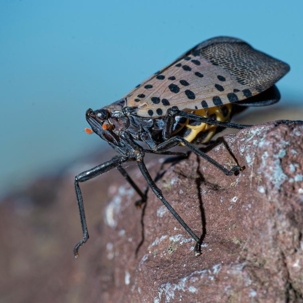Can Lanternflies Bite?
No, lanternflies (Spotted Lanternflies, Lycorma delicatula) do not bite people. They lack the mouthparts necessary to bite or chew. Instead, they have a specialized piercing-sucking mouthpart, similar to a straw, which they use to feed on the sap of trees, vines, and other plants—not on animals or humans. While they don’t bite or sting, they can still be annoying and indirectly harmful. Here’s why:
Sap Feeding Damage – Lanternflies feed on plant sap, weakening trees, vines, and crops such as grapes, maples, and black walnuts. Heavy infestations can stress plants, reduce yields, and even cause dieback.
Honeydew and Sooty Mold – Their feeding causes them to excrete large amounts of sticky honeydew, which coats leaves, decks, cars, and outdoor furniture. This attracts sooty mold, a black fungus that can further damage plants and create unsightly messes.
Nuisance to People – When disturbed, lanternflies may hop or fly toward people, creating a nuisance, especially during late summer and fall when adult populations are at their peak. But again, this behavior is not aggressive—they’re simply startled or disoriented.
Lanternflies cannot bite humans, but they are still a serious pest due to their destructive feeding habits and the mess they leave behind.
Do Lanternflies Bite?
Lanternflies are not known to bite people in any situation — even when handled directly. They do not have biting or chewing mouthparts, so they are physically incapable of biting skin. Their mouthparts are designed only to pierce plant tissue and suck sap, not to penetrate or injure animal flesh.
That said, some people may mistakenly believe they’ve been bitten by a lanternfly because:
Defensive reactions – When caught or swatted, a lanternfly might jump suddenly or flutter its wings, which can startle someone and feel like a bite.
Sharp legs – Their legs have small spines that can feel prickly if they land or crawl on bare skin, occasionally causing a mild scratching or tickling sensation.
Coincidental irritation – If someone experiences redness or itching after contact, it’s likely from skin sensitivity, allergic reaction to their secretions, or contact with honeydew or mold, not from a bite.
There are no situations in which lanternflies truly bite people. They do not seek out or feed on humans, and any discomfort caused by them is incidental and harmless.
Lanternfly Bites
A lanternfly “bite” isn’t a real bite — since spotted lanternflies (Lycorma delicatula) cannot pierce or feed on human skin — but some people who come into contact with them may experience minor skin irritation that’s mistaken for a bite. Here’s what that may look like and why it happens:
Mild Redness or Small Bumps: Occasionally, if a lanternfly lands on someone or is crushed against the skin, a person with sensitive skin might develop a small red spot, slight swelling, or an itchy patch. This reaction is not due to venom or a bite, but rather contact irritation—similar to a mild allergic response to the insect’s body fluids or excretions (honeydew).
No Puncture Wound: Unlike real insect bites (such as bites from mosquitoes or spiders), there’s no puncture mark or center dot, because the insect’s feeding structure isn’t designed to penetrate human skin.
Short-lived Reaction: Any irritation usually fades within a few hours to a day, especially after washing the area and applying a mild anti-itch cream or cold compress.
So, if someone believes they’ve been “bitten” by a lanternfly, what they’re likely experiencing is a harmless, short-term skin irritation, not an actual bite or envenomation.
Key takeaway: Lanternflies cannot bite people. Any “bite marks” are just mild contact reactions, not the result of feeding or aggression.

